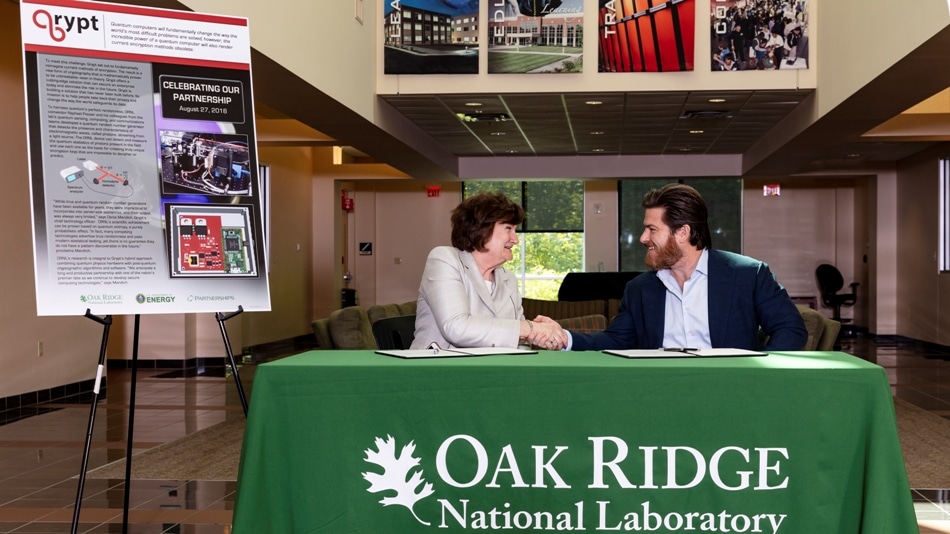Aug 29 2018
Qrypt, Inc., has exclusively licensed an innovative cyber security technology from the Department of Energy’s Oak Ridge National Laboratory, assuring a stronger defense against cyberattacks, such as those posed by quantum computing.
 ORNL’s Michelle Buchanan, left, and Qrypt founder and CEO Kevin Chalker signed a licensing agreement for novel cyber security technology that promises a stronger defense against cyberattacks including those posed by quantum computing. (Image credit: Carlos Jones/Oak Ridge National Laboratory, U.S. Dept. of Energy)
ORNL’s Michelle Buchanan, left, and Qrypt founder and CEO Kevin Chalker signed a licensing agreement for novel cyber security technology that promises a stronger defense against cyberattacks including those posed by quantum computing. (Image credit: Carlos Jones/Oak Ridge National Laboratory, U.S. Dept. of Energy)
Qrypt will integrate ORNL’s quantum random number generator (QRNG) into its current encryption platform, with the help of intrinsic quantum randomness to develop peculiar and unpredictable encryption keys that allow virtually impenetrable communications.
The emergence of quantum computing paves the way for an essentially innovative strategy to solve some of the most challenging and critical problems in the world. Yet, quantum computing will also make existing encryption techniques outdated and require a reimagined, quantum-based strategy to ensure data security.
“The cryptography we have developed is based on true quantum sources of entropy and is mathematically proven to be unbreakable—even in theory,” stated Denis Mandich, Qrypt’s chief technology officer at the company’s New York City office.
“Until recently, this class of technology was unavailable at the scale required to encrypt Internet-sized datasets,” stated Mandich. “Simply relying on increasing the complexity of cryptographic algorithms has again proven to be a failing bet.”
ORNL’s study is inherent to Qrypt’s hybrid strategy: merging quantum physics hardware with post-quantum cryptographic algorithms and software. “We anticipate a long and productive partnership with one of the nation’s premier labs as we continue to develop secure computing technologies,” he added.
One technique for ensuring successful, reliable encryption is to encode messages using encryption keys that are truly random. In other words, it is highly improbable to generate the exact key sequence used more than once.
ORNL coinventor Raphael Pooser and his collaborators—from the lab’s quantum sensing, computing, and communications groups—harnessed quantum’s perfect randomness by creating a quantum random number generator with the ability to detect the presence and characteristics of electro-magnetic waves, known as photons, streaming from a light source.
“A field of quadrillions of photons are produced and pass through a beam splitter,” stated Pooser. “Different from other QRNG technologies, our method does not require that we wait for a single photon to appear, but allows us to use the collective statistics of large numbers of them.”
The device developed by ORNL has the ability to detect and measure the quantum statistics of photons that exist in the field and use each one as the foundation for developing truly unique encryption keys that cannot be predicted or deciphered.
“While true and quantum random number generators have been available for years, they were impractical to incorporate into server size appliances and their output was always very limited,” stated Mandich.
He stated that the scientific accomplishment of ORNL can be proven based on quantum entropy, a purely probabilistic effect.
“Many competing technologies advertise true randomness and pass modern statistical testing, yet there is no guarantee they do not have a pattern discoverable in the future,” stated Mandich.
“Historically, patterns, predictability and repetition are a critical flaw for many crypto systems, allowing them to fall to basic cryptanalysis,” he added.
Qrypt will integrate ORNL’s technology into a suite of quantum-resistant encryption techniques and technologies, including a chip or card that allows quick encryption of vast datasets. Data safeguarded using this technology will be secure against attack by quantum computers or any futuristic computational device and advancements in the mathematics of cryptanalysis.